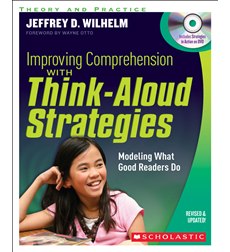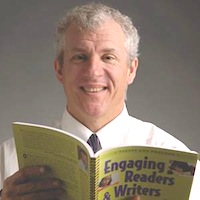Think-Aloud Strategies: New Edition of a Classic
Improving Comprehension with Think-aloud Strategies: Doing What Good Readers Do (2nd Edition)
By Jeffrey D. Wilhelm
(Scholastic, 2012 – learn more)
 Reviewed by Linda Biondi
Reviewed by Linda Biondi
How many times have you caught yourself thinking aloud, trying to work out a complex problem, and all of a sudden you have that “aha” moment? By restating and analyzing your problem, you’ve found possible solutions. Perhaps without realizing it, you’re relying on the skill of metacognition.
Jeffrey Wilhelm’s updated Improving Comprehension With Think-Aloud Strategies (2012), gives the reader an insight into “thinking aloud” – a protocol that highlights how to navigate a task or reading as it is being done. The book originally appeared in 2001 as part of a series about techniques for teaching students the process of reading and composing. The updated version comes with a DVD that includes videos of several teachers applying the strategies in their classrooms.

Wilhelm reaffirmed my philosophy that instead of modeling how to memorize facts, we need to spend time modeling how to think aloud through a wide range and variety of texts – such as in science, social studies, biology, math, physical education, and art.
What’s in the book
There isn’t any doubt about it. Wilhelm knows “his stuff,” which explains why his book is still popular more than a dozen years after it was first published. His updated and revised edition is aligned with Common Core State Standards and includes the DVD demonstrating think aloud strategies at work in classrooms. Each chapter is full of anecdotes from the classroom, guided lessons, links to the DVD that accompanies the book, and samples of student work.
Chapter One, “Frequently-Asked Questions About Think Alouds,” introduces the reader to the think-aloud concept by answering questions from classroom teachers. The questions, collected from Wilhelm’s workshops and emails, help the reader think about ways to introduce think alouds in the classroom.
- How do think alouds differ from “protocols”?
- Don’t think alouds interrupt the reading process?
- When would you use think alouds? How often? How do you use them?
- How do you choose a think –aloud text or excerpt? What good are think alouds? What can you think with them?
- Don’t the better readers get bored?
- What about assessing think alouds?
Wilhelm also addresses the primary challenge of teachers: motivation and engagement. We want our students to get lost in their learning, whether it is reading fiction or non-fiction, analyzing text or images. We want them to feel the passion we have for our subject and carry it into their own lives.

As educators, we are always hunting for new ideas to make teaching more relevant and exciting for our students without doing cartwheels and flips to get their attention. Throughout the book, Wilhelm peppers the pages with timely strategies to drive student interest. Just about every student loves sticky notes. Mr. Wilhelm’s creative examples of using them for comprehension monitoring is one technique that I immediately introduced into my classroom.
A few examples of Wilhelm’s ideas
Here’s his creative idea of how to have students “Flag the Text for Monitoring” comprehension. Divide students into groups with all students reading the same text and have them respond on colored sticky notes. Next, have them pool their notes onto one copy of the text. By giving them different colored sticky notes for personal connections, visualization and predictions, they are able to see the similarities and differences in strategies used by various readers in their groups.
Dr. Wilhelm provides other clear and precise suggestions to help students monitor their comprehension and move toward independent thinking. Here’s an excerpt from Chapter 5 – “Navigating Meaning: Using Think Alouds to Help Readers Monitor Comprehension.”
From Modeling to Students’ Independent Use: Basic Steps
TEACHER DOES/STUDENTS WATCH
To introduce my students to the notion of checking understanding while reading, I model a wide variety of fix-up strategies, help students identify them, and then post a list or flow chart of them in the classroom (see the following example). I tell the students that the strategies outlined here will help them monitor their comprehension and read better, no matter what they are reading.
TEACHER DOES/STUDENTS HELP
Then I read another text and ask students to help me go through the process we have outlined by prompting me and explaining the steps I should try.
STUDENTS DO/TEACHER HELPS
When the process of comprehension monitoring becomes relatively clear to them, students then take over the process themselves in small groups, and when ready, of course, begin to use the process on their own.
Tips for Guiding Students
- I start off telling students to continually pause and ask themselves the question: Does this make sense?
- I tell kids who answer “no, this isn’t making sense” to use the most basic fix-up strategies of I) rereading, 2) reading ahead, 3) skipping or filling in a word. I later introduce other strategies, some of which need to be modeled and taught more explicitly.[Read more about this strategy at this book excerpt on the National Writing Project website.]
Wilhelm reminds us:
Remember that any time you introduce a strategy and kids don’t or can’t use it, you must go back and do more modeling and provide more assistance. On the other hand, if kids quickly take to the strategy, let them take more responsibility for it, and move on to teach something else with which they are having more difficulty.
I highly recommend this book, in this new edition. Thinking is an art and a craft, and Jeff Wilhelm can help us help our students develop as both artful and skillful thinkers through the use of think-aloud strategies. As he says: “We need to move from places where kids only consume other people’s meaning to places where they create their own.”
Linda Biondi is a fourth grade teacher at Pond Road Middle School in Robbinsville, NJ, and a recipient of several educational grants that infuse a literacy enriched curriculum with an understanding of individual learning styles to help students understand bias and patterns of discrimination. She is a Teacher Consultant with the National Writing Project and a participant on the NJ Department of Education Teacher Advisory Panel.

 Reviewed by Linda Biondi
Reviewed by Linda Biondi

































